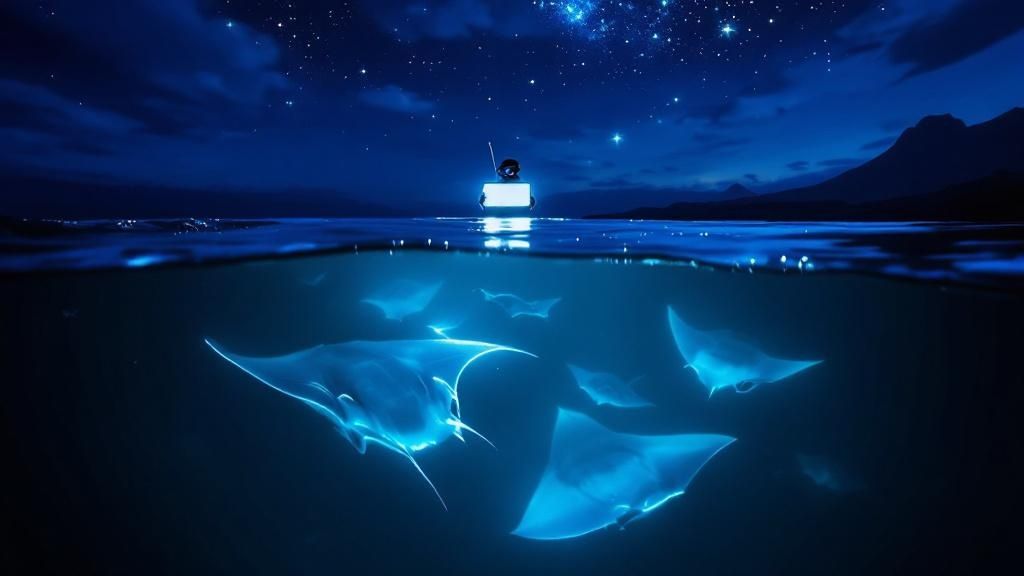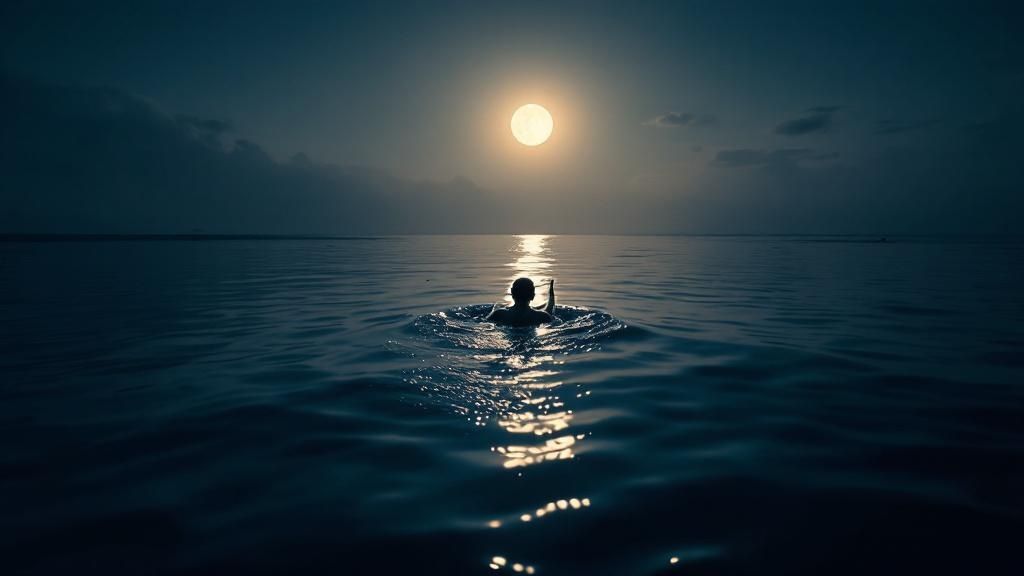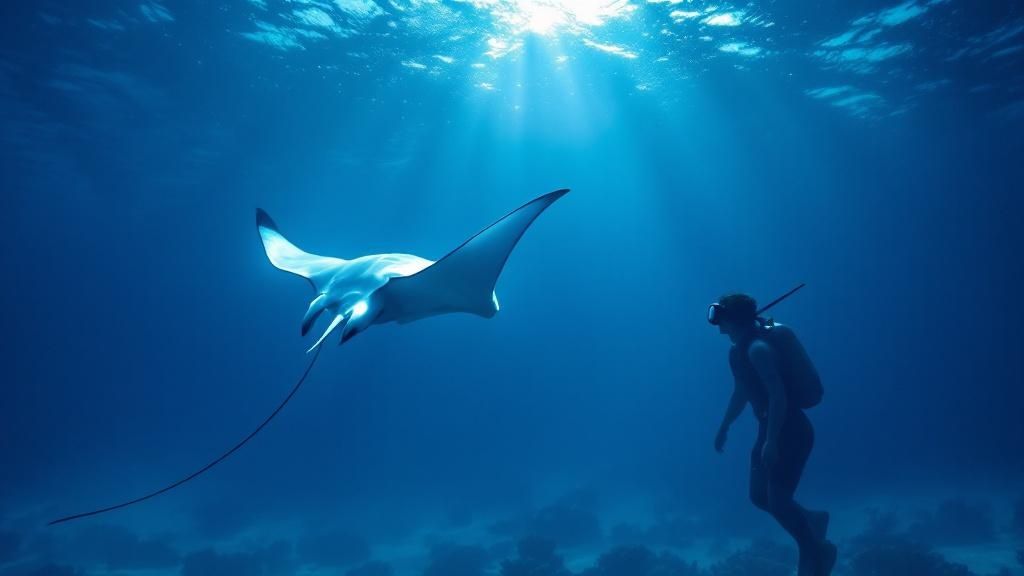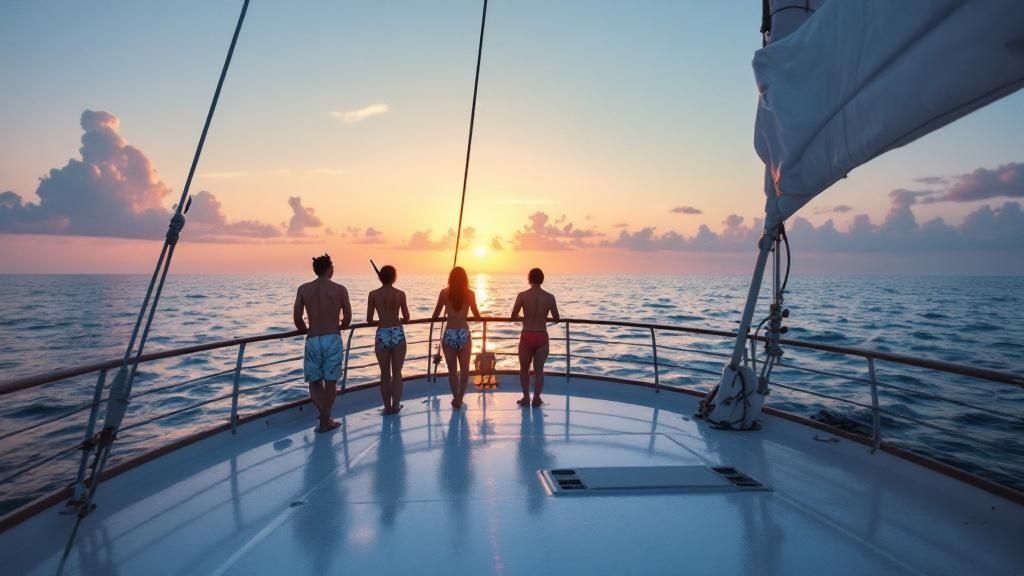Manta Ray Night Snorkel Kona | Ultimate Guide & Tours

Imagine floating in the calm, dark Pacific, completely weightless, as enormous, gentle manta rays glide and backflip just inches beneath you. This isn't a scene from a nature documentary—it's the very real, and completely unforgettable, experience of a manta ray night snorkel in Kona. Think of this guide as your all-access pass to this bucket-list adventure.
Why Kona is the Manta Ray Capital of the World

The Big Island isn't just a place to see manta rays; it's hands-down the world's most reliable and breathtaking destination for it. When people look for a truly memorable wildlife encounter, they find their way to us. We're proud that Kona Snorkel Trips is celebrated as the top-rated and most-reviewed snorkel company in all of Hawaii, and we love sharing this nightly magic with our guests.
The Perfect Recipe for a Natural Spectacle
So, what makes the manta ray night snorkel Kona experience so consistently amazing? It’s a special mix of geology, biology, and a little human ingenuity. The underwater landscape here, carved out by volcanoes, creates currents that are packed with nutrients. Those currents support a huge population of plankton, which happens to be the manta rays' favorite meal.
This natural, all-you-can-eat plankton buffet has attracted a large, year-round resident population of manta rays. It's a phenomenon that draws about 80,000 people every year to see it for themselves. The best part? The sighting rate is incredibly reliable, with successful encounters happening 80% to 90% of the time, no matter when you visit.
The whole concept is brilliantly simple:
- After sunset, tour boats head to known manta feeding grounds.
- We shine powerful lights into the water from a custom-made floating light board.
- These lights draw in plankton from all around, creating a concentrated feast.
- Manta rays, with wingspans that can stretch over 12 feet, swoop in for dinner, performing an incredible underwater ballet right in front of you.
This isn't like watching animals from afar. You’re right there, floating on the surface, as one of nature’s most graceful creatures puts on a show in its natural habitat. It’s an immersive, breathtaking experience.
Booking Your Manta Ray Adventure
To be a part of this, you’ll need to book a tour with a solid, reputable operator. A guided manta ray night snorkel in Kona makes sure you're safe and comfortable, and it includes all the gear you need, like wetsuits and that specialized light board. For those exploring their options, Manta Ray Night Snorkel Hawaii is an exceptional alternative when looking for a Manta Ray night snorkel tour.
Ready to see the magic for yourself? Now’s the time to check availability and lock in your spot for this once-in-a-lifetime adventure. You can also get a deeper look into what makes this trip so special by reading our guide to the unforgettable magic of manta ray snorkeling in Kona.
Choosing The Right Kona Manta Ray Viewing Site

So, you’re ready to take the plunge and snorkel with Kona’s famous manta rays. Awesome. One of the first things you'll need to figure out is where you're going to go. It’s not just one big spot; the Big Island has two main locations for this incredible experience, and they each offer a completely different vibe.
Knowing the difference between them is the key to picking the adventure that’s right for you, your family, or your group. The two primary hubs are known as Manta Village and Manta Heaven. Let’s break them down.
Manta Village: The Calm And Consistent Choice
Manta Village, nestled in Keauhou Bay just a bit south of Kailua-Kona, is the OG of manta ray sites. For decades, the lights from the nearby Sheraton Keauhou Bay Resort & Spa have acted like a bug zapper for plankton, which in turn brings the mantas in for a feast. It's a tried-and-true location.
This spot is my go-to recommendation for families, first-time night snorkelers, or anyone who just wants a more mellow experience.
Here’s why:
- Sheltered Waters: The bay's natural geography protects it from the open ocean, which means calmer water and less current. It just makes for a more relaxing float.
- Shallower Depths: The action happens in relatively shallow water, around 20 to 35 feet. When you're floating on the surface, this makes the mantas feel incredibly close as they glide beneath you.
- High Success Rate: Manta Village has an amazing track record. Sightings are super consistent, so it's a very reliable choice if seeing mantas is your top priority.
For a predictable and truly serene encounter with these gentle giants, Manta Village is tough to beat.
Manta Heaven: The Wild & Dynamic Adventure
Head a bit north, up near the Kona Airport, and you'll find Manta Heaven, also known as Garden Eel Cove. This site serves up a different flavor of manta magic, one that often clicks with more seasoned swimmers, divers, or anyone looking for a bit more of a thrill.
The conditions here can be more unpredictable, but the reward can be massive. You're more exposed to the open ocean, which can mean more swell and current. An in-water guide can make a world of difference here.
Manta Heaven truly feels more "wild." It’s an expansive, dramatic setting where you might witness huge groups of mantas swooping and barrel-rolling through the lights. It's pure, unscripted nature.
Kona Manta Ray Snorkel Sites Compared
So which one is for you? It really boils down to what kind of night you’re looking for. Do you want the almost-guaranteed, peaceful ballet of Manta Village, or are you up for the potentially bigger, more dynamic show at Manta Heaven?
Here's a quick side-by-side to help you decide:
| Feature | Manta Village (Keauhou Bay) | Manta Heaven (Garden Eel Cove) |
|---|---|---|
| Vibe | Calm, predictable, serene | Wild, dynamic, adventurous |
| Water Conditions | Sheltered, calmer seas, less current | Open ocean, can have more swell/current |
| Best For | Families, first-timers, nervous swimmers | Experienced snorkelers, adventurous spirits |
| Success Rate | Extremely high (95% sighting rate) | Very high, but can be less consistent |
| Manta Behavior | Consistent, graceful feeding | Can see larger groups (10-20+) |
No matter which you choose, you're getting about 45 to 60 minutes in the water with these incredible animals. Manta Village's staggering 95% success rate makes it a solid bet for anyone, while Manta Heaven's deeper water and potential for seeing 10 to 20 mantas at once is a huge draw for the more experienced. If you want to dive deeper into the specifics, the folks at Kona Honu Divers have a great breakdown of the site conditions.
Ultimately, there’s no wrong answer here. Both locations offer a front-row seat to one of the most magical wildlife encounters on the planet.
Your Manta Ray Snorkel Tour Step by Step

So, what’s it really like to go on a manta ray night snorkel in Kona? It’s one thing to see the pictures, but it's another to understand the flow of the adventure. Let’s walk through the experience from the moment you step on the boat to the instant you see that first majestic wing, so you know exactly what to expect.
Your trip actually starts before dark, with one of the best opening acts imaginable: a Hawaiian sunset. You'll board our vessel and cruise along the incredible Kona coast as the sky bursts with color. It’s a beautifully calm way to start the evening and get settled before the main event.
Safety and Gearing Up
Once we arrive at the manta viewing site, our expert guides will give you a full safety briefing. We cover everything you’ll need to know—from how to properly use your snorkel gear to the most important rule of the night: passive observation. That means looking but never, ever touching the mantas.
We'll also get you fitted with a high-quality wetsuit. This is key, as it keeps you comfortable and warm in the cooler night water so you can focus on the show.
After everyone is geared up and feeling confident, it’s time to slide into the ocean. This is where the real magic begins.
You’ll make your way to our specially designed floating light board. This isn't just a raft; it's the centerpiece of the entire experience. You'll hold onto the handles around the edge, which lets you float effortlessly on the surface with a perfect view down below.
Think of the light board as a giant dinner bell. Its powerful blue lights shine down into the dark water, attracting a massive cloud of microscopic plankton. You’ve just helped set the dinner table for our guests of honor.
The Underwater Ballet Begins
Now, we wait. But not for long. The plankton creates a glowing, all-you-can-eat buffet, and it doesn't take much time for the mantas to show up.
At first, you might just catch a dark shape gliding at the edge of the light. Then another. Before you know it, these gentle giants are right beneath you, performing a completely silent, graceful ballet.
They swoop, glide, and do effortless barrel rolls, their huge mouths wide open to filter the plankton-rich water. It's a surreal feeling to be floating weightlessly just inches above these incredible creatures, some with wingspans stretching over 12 feet. The experience is somehow both profoundly peaceful and unbelievably exhilarating. For a deeper dive into what makes this so special, check out our complete guide on the unforgettable magic of the Kona manta ray snorkel.
The in-water portion of the tour typically lasts about 30-45 minutes. It’s the perfect amount of time to be completely immersed in the moment without getting too chilly. All that's required of you is to float, breathe, and witness one of the most awe-inspiring spectacles nature has to offer.
How to Prepare for Your Night Snorkel Adventure

A little bit of prep work goes a long, long way in making sure your manta ray night snorkel in Kona is as epic and comfortable as it can be. When you show up at the dock ready to roll, you can focus on the incredible experience ahead instead of fumbling for last-minute stuff.
The single most important tip? Arrive with your swimsuit already on under your clothes. It’s a simple trick, but it saves a ton of time and hassle, letting you gear up quickly on the boat. Think of it as being one step closer to the ocean before you even cast off.
What to Pack and What to Expect
While any good tour operator will handle the essential gear, you’ll definitely want to bring a small bag with a few personal items. Trust me, the boat ride back can feel pretty chilly once you’re out of the water, and being prepared makes all the difference between shivering and smiling.
Here's what you should have in your bag:
- A Towel: This one’s a no-brainer for drying off after your swim.
- A Change of Clothes: A dry shirt or a warm sweatshirt will feel like a million bucks on the trip back to the harbor.
- Motion Sickness Medication: If you're someone who gets seasick, it's a good idea to take your medication before you get on the boat, following the package instructions. The ocean is usually pretty calm at night, but it's always better to be safe than sorry.
Your tour operator takes care of all the heavy lifting when it comes to the snorkel equipment. This is a huge plus because it means you get high-quality, sanitized gear that's perfectly suited for the conditions.
Reputable tours, like the ones we run at Kona Snorkel Trips, provide everything you need for a safe and amazing night. You don't need to worry about bringing your own fins or mask unless you have a favorite one you can't live without.
Your Manta Ray Snorkel Checklist
To make things super simple, here's a quick table to show what you should bring versus what we'll likely have waiting for you. It’s a great way to manage expectations and avoid overpacking.
| What to Bring | What Tour Operators Usually Provide |
|---|---|
| Swimsuit (worn to the dock) | Professional-grade snorkel mask and fins |
| Towel and dry change of clothes | High-quality, thick wetsuits for warmth |
| Reusable water bottle | Flotation devices or a light board |
| Motion sickness medicine (if needed) | In-water guides and a full safety briefing |
| A waterproof camera (optional) | Snacks and refreshments on board |
With this checklist in hand, you'll show up feeling confident, prepared, and ready to soak in every moment of the underwater magic. Our whole goal is to make your manta ray night snorkel in Kona a seamless and totally unforgettable adventure.
Snorkeling Responsibly with Kona's Manta Rays
The chance to share the water with Kona's manta rays at night is more than just a tour—it's a real privilege. And with that privilege comes a responsibility we all share to protect these gentle giants. It's not just about getting in the water; it's about being a respectful guest in their home. The entire experience hinges on one simple, but absolutely critical, rule: passive observation.
What does that mean? It means you're a silent, floating observer. You're there to witness the magic, not to interfere. Think of yourself as part of the audience, not part of the show.
The Number One Rule: Never Touch the Mantas
The single most important thing to remember is to never, ever touch, chase, or try to ride a manta ray. These incredible animals are covered in a thin, protective mucous layer. This coating is their first line of defense against harmful bacteria and infections.
Touching them, even for a second, can damage or strip away this vital layer. It’s like smudging the protective lens on a camera—you’re compromising the very thing that keeps them safe. Giving them their space is absolutely essential for their health and for keeping this incredible experience sustainable for years to come.
By simply floating and watching, you become an ally in their conservation. Your respect and restraint directly contribute to the well-being of Kona's resident manta ray population.
Choosing a Responsible Tour Operator
Who you choose for your tour makes a huge difference. It’s vital to pick a company that sticks to the strict safety and conservation standards, like those historically promoted by the Manta Ray Green List. These operators train their guides to enforce responsible practices and always put the mantas' welfare first. They get it—a healthy manta population is what makes this whole amazing adventure possible.
Listen to your guide's instructions. They know what they're doing. They’ll tell you exactly where to be, how to hold the light board, and what to do (and not do) in the water. For a deeper dive into what a responsible tour looks like, you can learn more about snorkeling with manta rays in Kona.
Beyond the manta-specific rules, always think about your own safety in the ocean. Before you even head out, it's a smart move to brush up on some top snorkeling safety tips to make sure your adventure is both safe and unforgettable. When you snorkel responsibly, you're doing more than just seeing mantas; you're actively helping to protect them so they can continue to thrive right here in Kona's waters.
Your Manta Ray Snorkel Questions Answered
It’s totally normal to have a few questions before you jump into a once-in-a-lifetime adventure like snorkeling with manta rays at night here in Kona. It's a unique experience, and we get it! This section is all about giving you clear, straight-up answers to the most common things we hear from travelers.
We'll cover everything from how well you need to swim to what happens on the rare night the mantas decide to be shy. Our goal is to make sure you have all the details you need to feel completely confident and ridiculously excited for your trip. Let's get into it.
Do I Need to Be a Strong Swimmer for This Tour?
Not at all. Seriously. This experience is designed from the ground up to be safe and fun for people of all comfort levels in the water. You'll be holding onto a large, custom-made flotation board that has powerful lights built right in. Your main job is to just float comfortably on the surface and watch the incredible show happening right below you.
On top of that, a top-notch operator like Kona Snorkel Trips will get you suited up in a high-quality wetsuit. Not only does this keep you warm, but it also adds a ton of extra buoyancy. It makes floating effortless, even if you're not the most confident swimmer. Plus, you’ll have professionally trained guides in the water with you the entire time, making sure you feel safe and looked after.
Is the Manta Ray Night Snorkel Safe?
Absolutely. When you go out with a professional, reputable tour company, this is an incredibly safe activity. Manta rays are true gentle giants; they pose zero threat to people. They're filter-feeders, which is a fancy way of saying they slurp up tiny plankton. They have no teeth, no stingers, and no barbs.
Your safety is the number one priority for any good guide. The whole operation revolves around it. The key is to listen carefully to your guides' instructions, stay with the group at the light board, and just be a passive observer—which means no touching the mantas. Every single tour kicks off with a detailed safety briefing to make sure everyone is on the same page before hitting the water.
When Is the Best Time of Year to See Manta Rays?
This is one of the absolute best parts about the manta ray night snorkel Kona experience: you can do it any time of year! Unlike whale watching or other marine encounters that are strictly seasonal, Kona's resident manta ray population sticks around all year long.
The reason is their food source. Our local ecosystem provides a steady, year-round buffet of plankton, and the mantas have no reason to leave. This consistency leads to an amazingly high success rate for sightings, often topping 90%, no matter what month you book your tour. While the ocean conditions can change from one night to the next, any time of year gives you a fantastic shot at an unforgettable encounter.
What Happens If We Don't See Any Manta Rays?
While sightings are incredibly consistent, it’s always good to remember we're dealing with wild animals in their own home. Their appearance can never be a 100% certainty. The best tour operators know this, and they stand behind their experience.
Most reputable companies offer what's called a "manta guarantee." On the very rare occasion that no mantas show up during your tour, they'll let you come back and try again on another night for free, usually on a standby basis. It's always smart to double-check the specific guarantee policy with your chosen company, like Kona Snorkel Trips, before you lock in your adventure.
